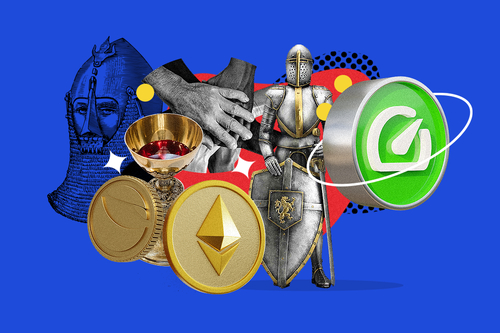

The Holy Grail of Crypto: Solving the Blockchain Trilemma
This one simple concept is what separates future-proof crypto projects from shitcoins.
Updated Apr 15, 2022
Many companies on MoneyMade advertise with us. Opinions are our own, but compensation and in-depth research determine where and how companies may appear.
Crypto
Technology
Balanced Investing
“You can have it good, fast or cheap. Pick any two.”
This so-called Project Management Triangle refers to the unavoidable trade-off engineers have to make during the development process.
The blockchain trilemma is a framework that says that every public blockchain has to sacrifice on one of three features: decentralization, security or scalability.
Now the key to solving the Project Management Triangle is prioritization. In other words, what matters most to you and your users? Turns out, crypto developers have their own version of the Project Management Triangle called the Blockchain Trilemma.
But why should you care? Well, the way each project goes about solving the Blockchain Trilemma will determine whether:
- All token holders have equal access and voting power in the network
- The network can resist attacks that try to shut it down or steal funds from user wallets
- Your favorite project will be able to support mainstream adoption
A blockchain project that can do all three of those things will have found the holy grail of crypto: a lasting solution to the Blockchain Trilemma. In this article, we’ll explore the root of the problem, how Layer 1 and Layer 2 solutions are trying to solve the trilemma, and how five of the top blockchain projects stack up in that regard.
The pros and cons of decentralized networks
The pros and cons of decentralized networks
To understand the Blockchain Trilemma, we first have to understand the differences between centralized and decentralized networks.
Centralized networks
A centralized network is a group of interconnected computers (i.e. nodes) that depend on one master node to store and process data. Most of the web apps we use today, like Google, YouTube and Facebook, are built as centralized networks that serve content to end-user devices.
There's a good reason for that too. Centralized networks are:
- Faster because all nodes answer to one master.
- Easier to maintain because only one server needs to be updated.
But on the flipside, centralized networks are also:
- More prone to crashes because they have a single point of failure.
- More vulnerable hacks because attackers only need to compromise one target.
Distributed & decentralized networks
Distributed networks, on the other hand, consist of interconnected nodes that share the workload. These nodes are often spread out across the globe but might still follow some kind of leadership hierarchy. Hence, distributed networks still allow for partial centralization.
The internet is the largest example of a distributed network, consisting of internet service providers (ISPs) that are privately owned (centralized) by large corporations.
A decentralized network takes the idea of distributed networks one step further by removing all forms of centralized leadership (in theory). To make the whole system work, nodes have to agree (i.e. reach a consensus) on what records are valid. The particular method they use to make decisions is called a consensus mechanism.
In doing so, decentralized networks are:
- More resilient, as one failed node doesn’t bring down the whole system
- More transparent since data is broadcasted for everyone to see
- More corruption-resistant, since attackers can’t manipulate the system without help from a majority
But decentralized networks do have their trade-offs, like:
- They are difficult to maintain because every single node needs to be updated.
- You can’t police bad actors because the system is permissionless.
- Not every node is equal, some have more data and processing capabilities than others.
While there are many unique challenges to running decentralized networks, most of them can be grouped into 3 categories that make up the blockchain trilemma.
What is the Blockchain Trilemma?
What is the Blockchain Trilemma?
The blockchain trilemma is a framework that says that every public blockchain has to sacrifice one of three features: decentralization, security, or scalability. Let’s dive into each.
Decentralization
One key thing is required for decentralization: a large number of independent nodes distributed across the globe. But here’s the kicker. Since every single node has to reach consensus before a transaction is finalized, becoming more decentralized actually slows down a network. And that’s not good for global adoption.
Security
Now to make a network faster, you actually want to reduce the total number or distance between nodes. But that raises the issue of security.
For a distributed network to reach consensus, a majority (51%) of nodes have to agree. So the fewer nodes there are, the easier it becomes for hackers to take control of the network through a 51% attack and print infinite money for themselves (also called the double-spending problem).
A fork of the Ethereum network (ETH) called Ethereum Classic (ETC) actually suffered from 51% attacks multiple times in 2020, costing users millions of dollars. All because the network was too small and thus easy to control.
In addition to that, blockchain security requires each node to have skin in the game. In other words, it needs to cost them something to participate—for instance, computing power or financial collateral.
But why? Otherwise, malicious actors would carry out Sybil attacks, spamming a network with transactions until it crashes. Solana (SOL), for instance, was knocked offline on September 14, 2021, after hackers flooded the network with up to 400K transactions per second.
Scalability
Okay so clearly decentralization and security are non-negotiable. But what does that mean for scalability, a blockchain’s ability to maintain or increase speed even as new users join the network?
For blockchains that don’t want to compromise on decentralization, that means slower transactions. Bitcoin, for instance, is only able to process 7 transactions per second (TPS). Blockchains like BNB, on the other hand, choose to be centralized for the sake of blazing-fast transaction speeds.